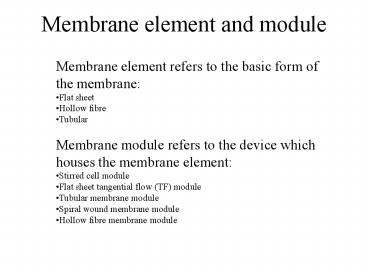Membrane element and module - PowerPoint PPT Presentation
1 / 12
Title:
Membrane element and module
Description:
Membrane element and module. Membrane element refers to the basic form ... Similar plate and ... e.g. membrane zeta potential. Ultrafiltration. Uses: ... – PowerPoint PPT presentation
Number of Views:704
Avg rating:3.0/5.0
Title: Membrane element and module
1
Membrane element and module
- Membrane element refers to the basic form of the
membrane - Flat sheet
- Hollow fibre
- Tubular
- Membrane module refers to the device which houses
the membrane element - Stirred cell module
- Flat sheet tangential flow (TF) module
- Tubular membrane module
- Spiral wound membrane module
- Hollow fibre membrane module
2
Stirred cell
- Research and small-scale manufacturing
- Used for microfiltration and ultrafiltration
- Excellently suited for process development work
3
Flat sheet tangential flow module
- Similar plate and frame filter press
- Alternate layers of membranes, support screens
and distribution chambers - Used for microfiltration and ultrafiltration
4
Spiral flow membrane module
- Flat sheet membranes are fused to form an envelop
- Membrane envelop is spirally wound along with a
feed spacer - Filtrate is collected within the envelope and
piped out
5
Tubular membrane module
- Cylindrical geometry wall acts as the membrane
- Tubes are generally greater than 3 mm in diameter
- Shell and tube type arrangement is preferred
- Flow behaviour is easy to characterise
6
Hollow fibre membrane module
- Similar to tubular membrane module
- Tubes or fibres are 0.25 - 2.5 mm in diameter
- Fibres are prepared by spinning and are potted
within the module - Straight through or U configuration possible
- Typically several fibres per module
7
Membrane modules
8
Flow patterns in membrane module
9
Membrane characterization
- The performance of a membrane process depends on
the properties of the membrane - Mechanical strength e.g. tensile strength,
bursting pressure - Chemical resistance e.g. pH range, compatibility
with solvents - Permeability to different species e.g. pure water
permeability, gas permeability - Average porosity and pore size distribution
- Sieving properties e.g. Nominal molecular weight
cut-off - Electrical properties e.g. membrane zeta potential
10
Ultrafiltration
Uses Concentration of macromolecules Purification
of solvent by removal of solutes Fractionation
of macromolecules Clarification Retention of
catalysts Analysis of complex solutions for
specific solutes Applications Fractionation of
biological macromolecules e.g. proteins,
DNA Concentration of polymer solutions Removal of
LMW solutes from protein solutions Removal of
cells and cell debris from fermentation
broth Virus removal from therapeutic
products Harvesting of biomass e.g., cells and
sub-cellular products Membrane bioreactors Effluen
t treatment
11
Ultrafiltration membranes
- Pores 10 to 1000 Angstroms
- Generally anisotropic (skin layer 0.2 to 10
micron thick) - Properties of an ideal ultrafiltration membrane
- High hydraulic permeability to solvent
- Sharp retention cut-off properties The
membrane must be capable of retaining completely
nearly all the solutes above some specified
value, known as the molecular cut-off (MWCO). - Good mechanical durability
- Good chemical and thermal stability
- Excellent manufacturing reproducibility and ease
of manufacture
12
Ultrafiltration Pore flow model
Jv Permeate flux ?m Membrane porosity dp
Average pore diameter ?P Transmembrane
pressure ? Viscosity lp Average pore length































